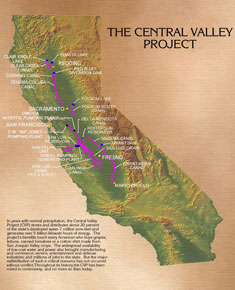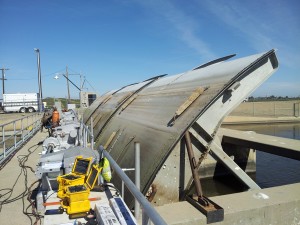The Central Valley Project, one of the Nation`s major water conservation developments, extends from the Cascade Range in the north to the semi-arid but fertile plains along the Kern River in the south. 
Initial features of the project were built primarily to protect the Central Valley from crippling water shortages and menacing floods, but the CVP also improves Sacramento River navigation, supplies domestic and industrial water, generates electric power, conserves fish and wildlife, creates opportunities for recreation, and enhances water quality.
The CVP serves farms, homes, and industry in California`s Central Valley as well as major urban centers in the San Francisco Bay Area; it is also the primary source of water for much of California`s wetlands. In addition to delivering water for farms, homes, factories, and the environment, the CVP produces electric power and provides flood protection, navigation, recreation, and water quality benefits.
Did you know that the CVP…
-
Reaches some 400 miles, from the Cascade Mountains near Redding in the north to the Tehachapi Mountains near Bakersfield in the south.
-
Consists of 20 dams and reservoirs, 11 powerplants, and 500 miles of major canals, as well as conduits, tunnels, and related facilities.
-
Manages some 9 million acre-feet of water.
-
Annually delivers about 7 million acre-feet of water for agricultural, urban, and wildlife use.
-
Provides about 5 million acre-feet for farms — enough to irrigate about 3 million acres, or approximately one-third of the agricultural land in California.
-
Furnishes about 600,000 acre-feet for municipal and industrial use–enough to supply close to 1 million households with their water needs each year.
-
Dedicates 800,000 acre-feet per year to fish and wildlife and their habitat and 410,00 acre-feet to State and Federal wildlife refuges and wetlands, pursuant to the Central Valley Project Improvement Act (CVPIA).
Source: U.S. Bureau of Reclamation
